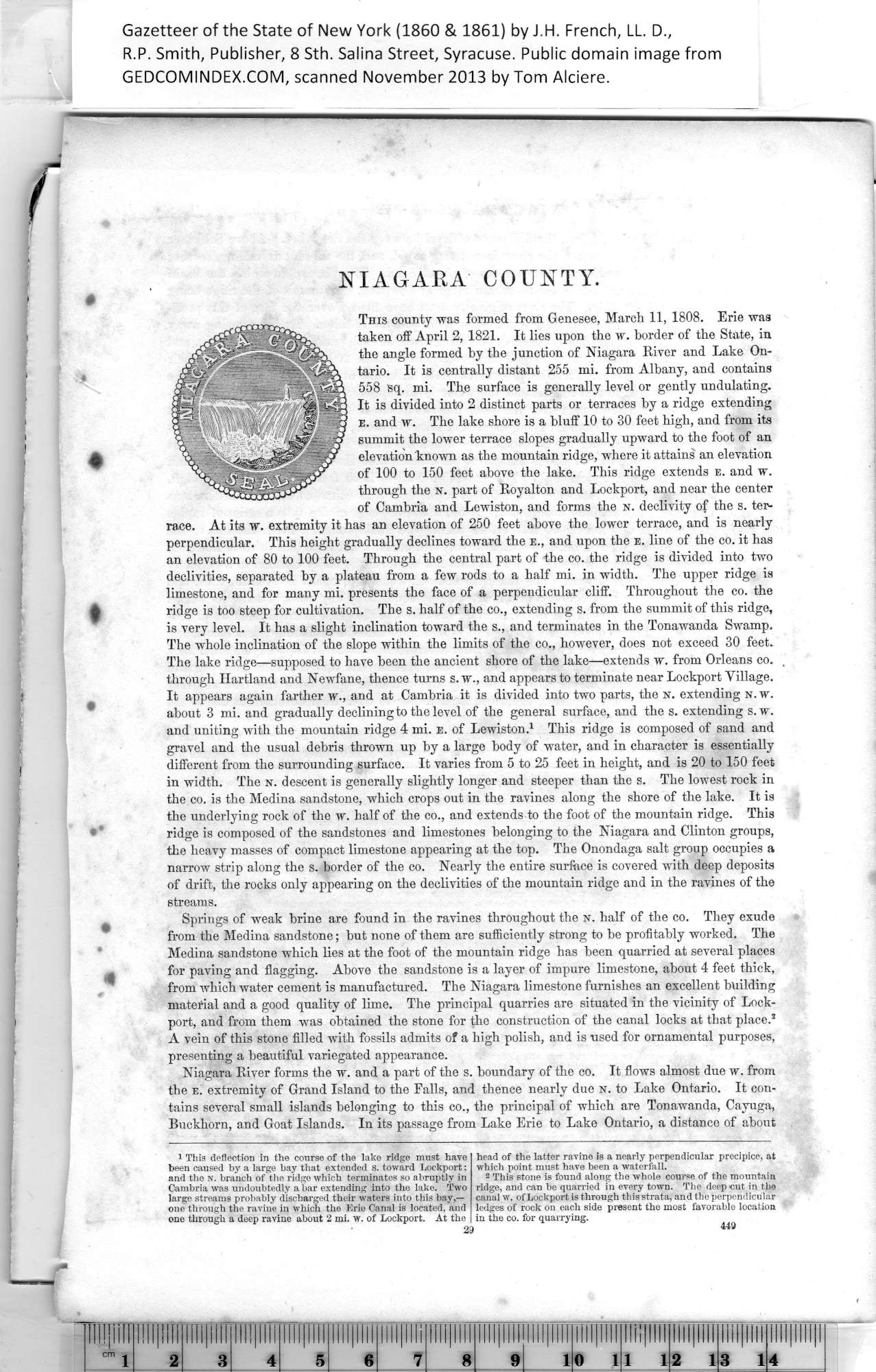|
NIAGARA COUNTY.
This county was formed from Genesee, March 11, 1808. Erie was
taken off April 2, 1821. It lies upon the w. border of the State, in
the angle formed by the junction of Niagara River and Lake On¬
tario. It is centrally distant 255 mi. from Albany, and contains
558 sq. mi. The surface is generally level or gently undulating.
It is divided into 2 distinct parts or terraces by a ridge extending
E. and w. The lake shore is a bluff 10 to 30 feet high, and from its
summit the lower terrace slopes gradually upward to the foot of an
elevation known as the mountain ridge, where it attains an elevation
of 100 to 150 feet above the lake. This ridge extends e. and w.
through the n. part of Royalton and Lockport, and near the center
of Cambria and Lewiston, and forms the n. declivity of the s. ter¬
race. At its w. extremity it has an elevation of 250 feet above the lower terrace, and is nearly
perpendicular. This height gradually declines toward the e., and upon the e. line of the co. it has
an elevation of 80 to 100 feet. Through the central part of the co. the ridge is divided into two
declivities, separated by a plateau from a few rods to a half mi. in width. The upper ridge is
limestone, and for many mi. presents the face of a perpendicular cliff. Throughout the co. the
ridge is too steep for cultivation. The s. half of the co., extending s. from the summit of this ridge,
is very level. It has a slight inclination toward the s., and terminates in the Tonawanda Swamp.
The whole inclination of the slope within the limits of the co., however, does not exceed 30 feet.
The lake ridge—supposed to have been the ancient shore of the lake—extends w. from Orleans eo.
through Hartland and Newfane, thence turns s. w., and appears to terminate near Lockport Village.
It appears again farther w., and at Cambria it is divided into two parts, the n. extending n.w.
about 3 mi. and gradually declining to the level of the general surface, and the s. extending s.w.
and uniting with the mountain ridge 4 mi. e. of Lewiston.1 This ridge is composed of sand and
gravel and the usual debris thrown up by a large body of water, and in character is essentially
different from the surrounding surface. It varies from 5 to 25 feet in height, and is 20 to 150 feet
in width. The n. descent is generally slightly longer and steeper than the s. The lowest rock in
the co. is the Medina sandstone, which crops out in the ravines along the shore of the lake. It is
the underlying rock of the w. half of the co., and extends to the foot of the mountain ridge. This
ridge is composed of the sandstones and limestones belonging to the Niagara and Clinton groups,
the heavy masses of compact limestone appearing at the top. The Onondaga salt group occupies a
narrow strip along the s. border of the co. Nearly the entire surface is covered with deep deposits
of drift, the rocks only appearing on the declivities of the mountain ridge and in the ravines of the
streams.
Springs of weak brine are found in the ravines throughout the n. half of the co. They exude
from the Medina sandstone; but none of them are sufficiently strong to be profitably worked. The
Medina sandstone which lies at the foot of the mountain ridge has been quarried at several places
for paving and flagging. Above the sandstone is a layer of impure limestone, about 4 feet thick,
from which water cement is manufactured. The Niagara limestone furnishes an excellent building
material and a good quality of lime. The principal quarries are situated in the vicinity of Lock¬
port, and from them was obtained the stone for the construction of the canal locks at that place.2
A vein of this stone filled with fossils admits of a high polish, and is used for ornamental purposes,
presenting a beautiful variegated appearance.
Niagara River forms the w. and a part of the s. boundary of the co. It flows almost due w. from
the e. extremity of Grand Island to the Falls, and thence nearly due n. to Lake Ontario. It con¬
tains several small islands belonging to this co., the principal of which are Tonawanda, Cayuga,
Buckhorn, and Goat Islands. In its passage from Lake Erie to Lake Ontario, a distance of about
|
head of the latter ravine is a nearly perpendicular precipice, at
which point must have been a waterfall.
2 This stone is found along the whole course of the mountain
ridge, and can be quarried in every town. The deep cut in the
canal w. of Lockport is through this strata, and the perpendicular
ledges of rock on each side present the most favorable location
in the co. for quarrying. |
29 449
1
This deflection in the course of the lake ridge must have
been caused hy a large bay that extended S. toward Lockport;
and the N. branch of the ridge which terminates so abruptly in
Cambria was undoubtedly a bar extending into the lake. Two
large streams probably discharged their waters into this bay,—
one through the ravine in which the Erie Canal is located, and
one through a deep ravine about 2 mi. w. of Lockport. At the
|
